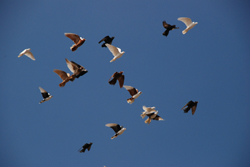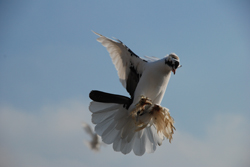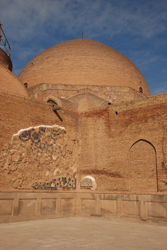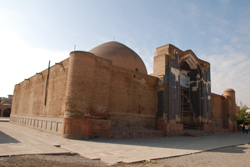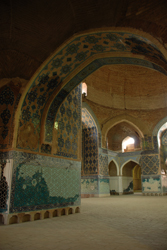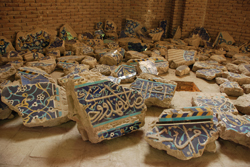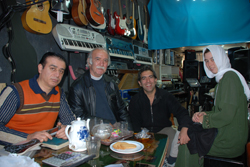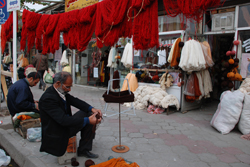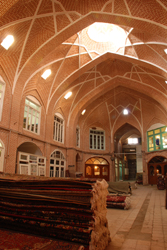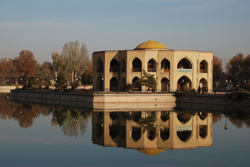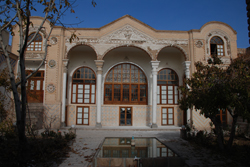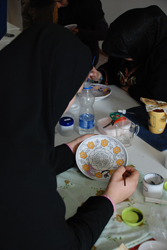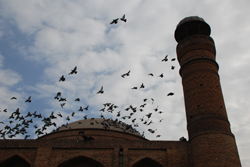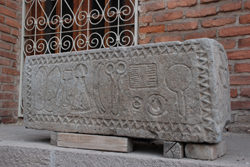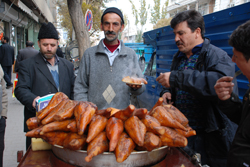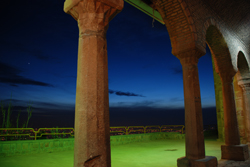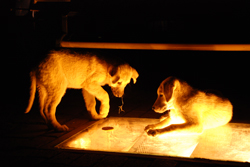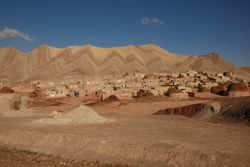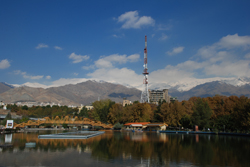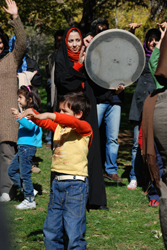Visiting the Sights of Tabriz
13 November, 2008, 02:21 am in "Iran"
Tabriz is cold. It is small, though it does sprawl. The streets have their share of traffic though not nearly as bad as in Tehran. The buildings are mostly brick, probably made from beige and red clay from the surrounding hills. The air is smoggy but sometimes a glimpse of mountains can bee seen through the haze. We drove along the former river bed, past the house where Rowshan was born-- or rather the site of the house. Now the space was covered with large apartment buildings. Rowshan said there used to be only a few houses. Now it was lined with buildings. There was work being done in the dry river bed. I guess they will be building a metro system. Rowshan said even when he was little it was dry except for when it flooded. Later, Rowshan said it was good they were working on it and cleaning because it used to be a place where people dumped their trash. As we were driving through town, we noticed an outdoor equipment store. Rowshan mentioned that Azeris were into hiking more than people from Tehran.
As we wandered around Tabriz, we often saw pigeons circling in the sky. Pigeon-keeping is a popular activity in Tabriz. One of Rowshan's cousins keeps pigeons. The roof of his house contains 3 or 4 pigeon hutches. The pigeons have huge clumps of feathers on their feet so some can barely walk.
The main site in Tabriz is the Blue Mosque which, from the outside, isn't blue at all. We approached from the back, noticing just a tiny patch of blue tile work remaining. The front had more but it was terribly chipped as if someone had gone at it with a hammer.
The inside had more intact sections (just in the lower parts) as well as plaster work showing how the tile work had once looked. At the front was a short bit of information stating the mosque had been extremely damaged during an earthquake. Black and white photocopies showed that it had really just been ruins of the lower parts of the building that remained. In the 70s, the building was reconstructed (and paid for) by a famous Tabriz architect. The dome still had scaffolding on it but that may have been a new thing.
A little down the street from the Blue Mosque was the remains of the Arg, a towered gateway of bricks covered with scaffolding. The whole area was surrounded by construction barricades shielding the new mosque being constructed next to it from the road. Later, one of Rowshan's cousins told us how 27 years ago he remembered the imam at the mosque wanted to destroy the ruins of the Arg to make more room for Friday prayers. The ruins proved so strong they had to blow them up with dynamite. They blew up a section but people were so outraged eventually UNESCO stepped in and made it a World Heritage site saying it belonged to the world and they could not destroy it.
The next stop was one of Rowshan's cousin's music stores. Rowshan wanted to play a joke on his cousin but as soon as he walked through the door of the shop, his cousin recognized him even though he hadn't seen him for 14 years.
The next stop was one of Rowshan's cousin's music stores. Rowshan wanted to play a joke on his cousin but as soon as he walked through the door of the shop, his cousin recognized him even though he hadn't seen him for 14 years.
Rowshan's cousin invited us to his house for lunch. On the way we stopped so he could pick up a couple ingredients. The street was both a yarn seller and butcher street. Skeins of freshly dyed yarn hung outside the shops in cheerful red garlands. Next door hung red cow carcasses.
Another famous site in Tabriz is the bazaar. It is a large brick structure which, when we visited, was very quiet for a bazaar. Perhaps it is busy in the morning. There were rows of gold sellers, another section of carpet sellers and food and spice areas. Tabriz is famous for its carpets.
The Shah Goli Park contains a lake with a concert hall in it and a hill which looks down on Tabriz. Rowshan remembered playing on the hill when it was just unmanicured trees. Now there were paved paths and other park additions.
After that we visited an old Tabriz house with beautiful exterior ganch work and a courtyard with a fountain. This was the home of a ceramics school. Inside was an impressive selection of beautiful ceramics. Some with painted designs based on traditional Persian motives, others with more contemporary designs. There were some beautiful plates with borders of birds made from strips of clay. I thought the pieces were some of the nicest and most original I'd seen in a while. Upstairs a decorating class was in session and we watched women learning to paint a floral and leaf design.
Other historic buildings in Tabriz including the Sahebol Amir Mosque which along with its tomb stones with Persian/Arabic inscriptions had an odd one with scissors, foot shapes and other objects on it. Near the mosque was a labu seller. The cold winter weather makes these hot carmelized turnips a popular item.
For the best view of the city of Tabriz, we went to the Enali Mountain with some of Rowshan's cousins. The cousins asked lots of questions about our travels and thought us very brave. We visited the holy tombs of 2 brothers and sat watching the dark of evening descend and the lights and stars come out. It was getting cold when we left, noting the stray dogs had settled on the inset ground lights in front of a monument to keep warm.
Tabriz: On the Way to Tabriz
12 November, 2008, 02:21 am in "Iran"
The road to Tabriz started out like a California highway, past dry hills and industrial buildings. I actually dozed off a bit telling Rowshan to wake me up when the road got interesting. Eventually, he woke me as we started going through a flat plain with small snowcapped mountains. The land became a painted landscape of wind-carved hills with ripples and stripes of yellow and red, and textures ranging from frosting peaks to curved hills.
One spot we stopped at for a moment revealed a mud walled village between a range of hills with zig-zagged stripes of red. The colors of the buildings reflected the earth around: one reddish, one beige, one darker gray. The highway went right by the town but had no direct route from the highway to the town, even farther down when there was a road, it seemed to go elsewhere. The highway is only a few years old and has no chaihanes, gas stations, or restaurants, or other services along it. It seemed like a good commercial prospect for someone in the village to set up a roadside cafe. However, I guess this was hard when there was no easy way for a car to get to the village. On the roofs of the houses, there were piles of hay, sometimes as big as the house. Piles of dried manure, fuel for the winter, were stacked outside.
We were going to have a picnic lunch by a lake not far from Tabriz but when we got there it had all been fenced off. The weather was also bitterly cold.
Later we learned the only way to get to the lake was to pay to be let through a gate. Rowshan said his family used to picnic there when they went they went to Tabriz. However, the last time he'd been to the lake was 30 years ago. The last time he'd been in Tabriz was for Behzad's wedding 14 years ago. Rowshan's dad seemed to get more excited and happy as we approached saying in English, I like Tabriz very much. The main reason we were visiting Tabriz is most of Rowshan's family lives there and I hadn't met them yet.
Terhan:Travel Plans Change
9 November, 2008, 02:21 am in "Iran"
While we were walking with Rowshan's parents in a park the other day, we heard the sound of a drum and singing. We approached and saw a crowd gathered around applauding. Some women were in the center. One was playing a daf. The others were singing and encouraging the audience to join in. They were singing (in Farsi) If you're happy and you know it clap your hands. Many of the people in the crowd were children. After that song they began one that went something like I made this shape, you can do it too. Where they did different positions with their arms and everyone followed. They ended with a hug telling everyone to hug someone they love. All the parents and children hugged each other.
It was very sweet. After the performance Rowshan's mom talked a little with the women. Every week they go to a different park and perform their program with the goal of making people happy.
Today Rowshan and I went to the Indian Embassy and realized we could only get a visa (w/ Iranian passport) for 1 month if we had a round trip ticket. Getting one with a US passport was extremely difficult since the Indian Embassy checks with applicant's embassy and there is no US Embassy in Iran. The Indian embassy was terribly crowded, not very helpful, and pissed Rowshan off. So we quickly started trying to figure out other options. In the end, we went to a travel agent and reserved a ticket to Kathmandu, Nepal via Sharjah in the UAE.
Today Rowshan and I went to the Indian Embassy and realized we could only get a visa (w/ Iranian passport) for 1 month if we had a round trip ticket. Getting one with a US passport was extremely difficult since the Indian Embassy checks with applicant's embassy and there is no US Embassy in Iran. The Indian embassy was terribly crowded, not very helpful, and pissed Rowshan off. So we quickly started trying to figure out other options. In the end, we went to a travel agent and reserved a ticket to Kathmandu, Nepal via Sharjah in the UAE.
Powered by My Blog 1.69. Copyright 2003-2006 FuzzyMonkey.net.
Created by the scripting wizards at FuzzyMonkey.net..
(Code modified by Rowshan Dowlatabadi)
Created by the scripting wizards at FuzzyMonkey.net..
(Code modified by Rowshan Dowlatabadi)



